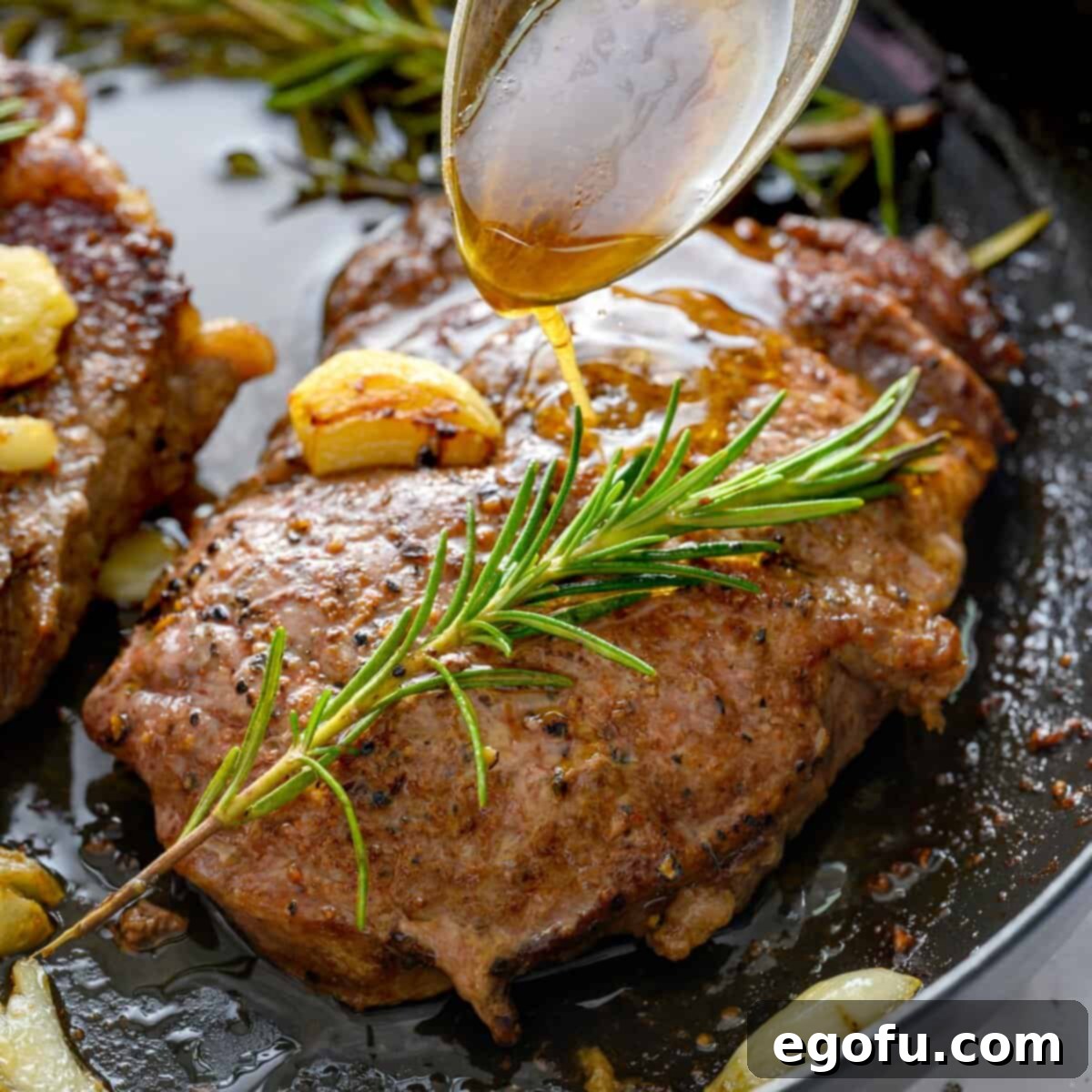Forget overpriced restaurant meals! Mastering a perfectly seared steak at home is easier than you think. With simple techniques and a few key ingredients, you can consistently cook succulent, flavorful, and truly restaurant-quality steaks right in your own kitchen. This guide will walk you through every step to achieve that coveted golden-brown crust and juicy, tender interior.
Mastering the Art of Pan-Seared Steak at Home
There’s an undeniable allure to a perfectly cooked steak. The sizzle as it hits the hot pan, the rich aroma that fills your kitchen, and finally, that first tender bite revealing a beautifully caramelized crust and a moist, flavorful center. While many associate such culinary delight with high-end steakhouses, the truth is that a pan-seared steak is a surprisingly accessible dish for any home cook. This method, emphasizing high heat and quick cooking, is not only efficient but also delivers a depth of flavor and texture that makes it a perennial favorite. Say goodbye to guesswork and hello to consistently delicious results with our comprehensive guide to pan-searing steak.
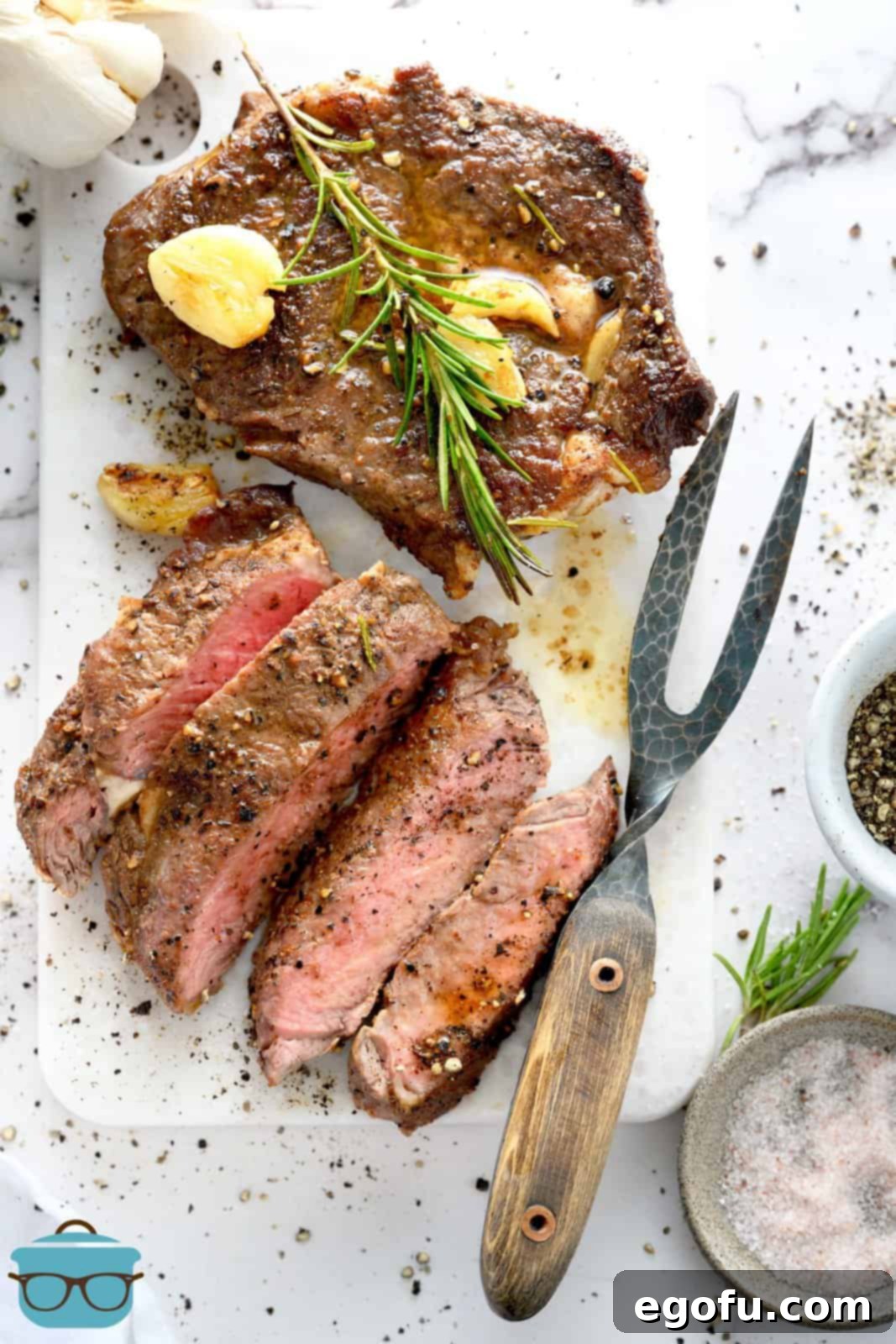
Why Pan-Searing is the Secret to a Perfect Steak
Pan-searing isn’t just a cooking method; it’s a culinary technique designed to maximize flavor and texture. The magic lies in the high heat of the pan, which rapidly creates a phenomenon known as the Maillard reaction. This chemical process, occurring when amino acids and reducing sugars react at high temperatures, is responsible for the steak’s irresistible brown crust and complex, savory flavors. Unlike grilling or baking, pan-searing allows for precise control over the heat and direct contact with the cooking surface, ensuring an even crust and a juicy interior without overcooking.
Beyond the incredible flavor, pan-searing offers practical advantages for the home cook. It requires minimal specialized equipment – primarily a good quality, heavy-bottomed pan – and can be executed quickly, making it ideal for weeknight dinners or impressing guests without hours of prep. It’s a method that truly elevates a simple cut of meat into a culinary masterpiece, proving that you don’t need a professional kitchen to achieve professional results.
Choosing the Ideal Cut for Pan-Searing
The foundation of a great pan-seared steak begins with selecting the right cut of meat. While many cuts can be pan-seared, some are undeniably superior for this method due to their fat content and tenderness.
- Ribeye: Often considered the king of pan-seared steaks, the ribeye boasts generous marbling – those fine streaks of fat that melt into the meat during cooking, imparting incredible juiciness and flavor. Its tender texture and rich taste make it a top choice for a luxurious dining experience.
- Sirloin: A close second favorite, sirloin offers a robust beefy flavor and a firmer texture than ribeye, with less marbling but still enough to keep it moist. It’s a more economical option that still yields fantastic results when pan-seared correctly.
- New York Strip: Also known as a strip steak or Kansas City strip, this cut features a good balance of tenderness and chew, with a distinct fat cap along one side that renders beautifully in a hot pan.
- Filet Mignon: While incredibly tender and lean, filet mignon can sometimes lack the deep beefy flavor of fattier cuts. If choosing a filet, consider wrapping it in bacon or basting generously to add flavor and moisture.
Regardless of the cut, aim for steaks that are at least 1 to 1.5 inches thick. This thickness allows for a beautiful, deep crust to form without overcooking the center, providing a wider window to achieve your desired doneness.
Essential Equipment for Pan-Searing
You don’t need a gourmet kitchen to achieve a perfect pan-seared steak. However, having the right tools can make all the difference:
- Cast Iron Skillet: This is arguably the most crucial piece of equipment. Cast iron heats evenly and retains heat exceptionally well, which is vital for creating a consistent, deep crust on the steak. Its heavy construction prevents temperature drops when the cold steak is added, ensuring efficient searing.
- High-Quality Stainless Steel Pan: If a cast-iron skillet isn’t available, a heavy-bottomed stainless steel pan can also work. Choose one that is thick enough to hold heat effectively. Avoid nonstick pans, as they generally cannot withstand the high temperatures required for proper searing and won’t develop the same quality of crust.
- Tongs: Essential for safely handling and flipping the hot steaks without piercing them, which can release valuable juices.
- Instant-Read Thermometer: Your best friend for achieving precise doneness. Guessing doneness by feel can be tricky; a thermometer provides an accurate reading and eliminates uncertainty.
- High-Heat Oil: Oils with a high smoke point (like olive oil, grapeseed oil, canola oil, or avocado oil) are necessary to prevent burning and unpleasant flavors at the high temperatures used for searing.

How to Make The Ultimate Pan-Seared Steak: A Step-by-Step Guide
Ingredients You’ll Need:
- Ribeye steaks (or preferred cut), 1-inch thick
- Salt
- Freshly ground black pepper
- Cajun seasoning (optional, for extra flavor)
- Olive oil (or any high heat oil)
- Unsalted butter
- Garlic cloves, smashed
- Fresh rosemary sprigs
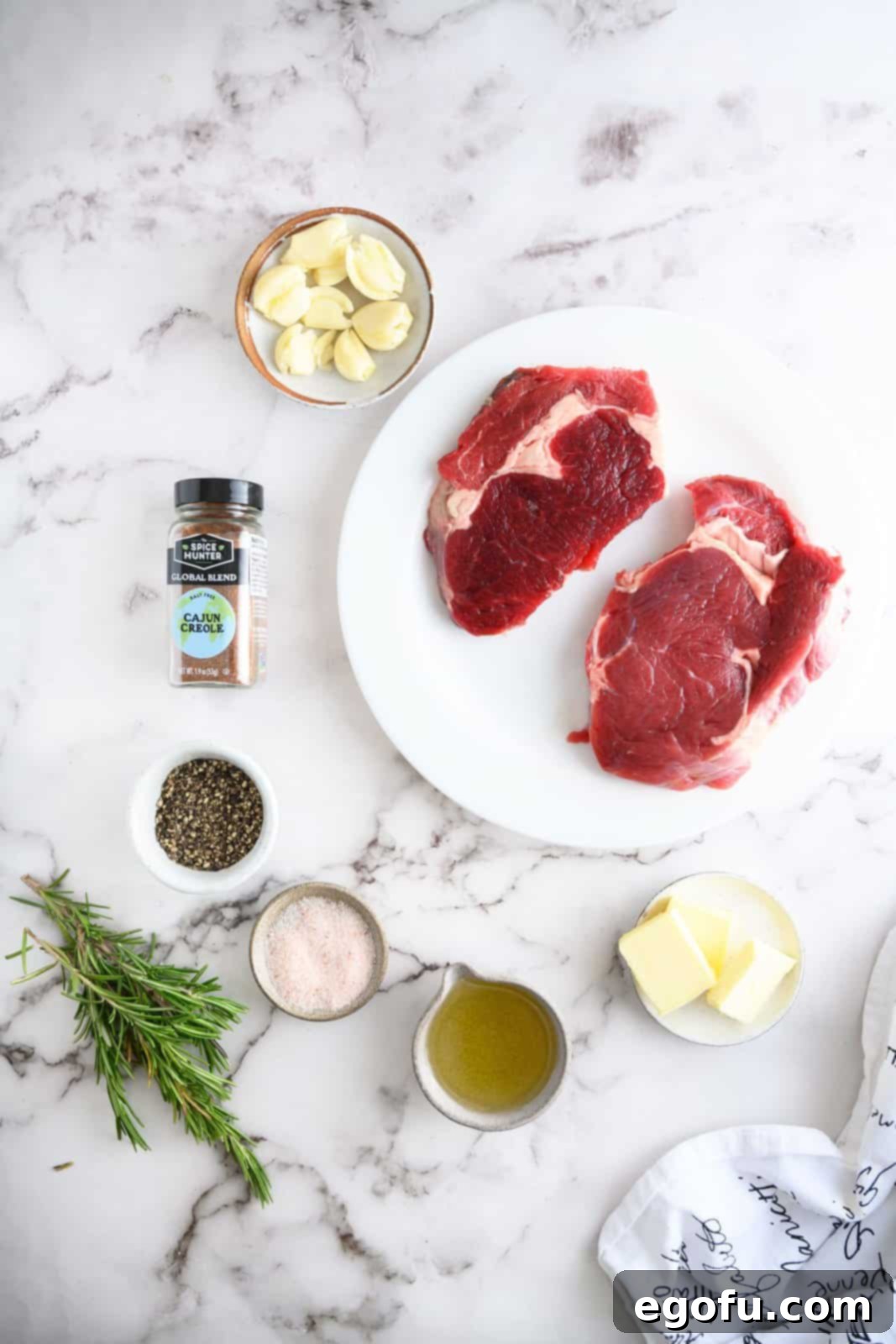
1. Preparing Your Steaks
For the best results, remove your steaks from the refrigerator about 30-60 minutes before cooking. This allows them to come closer to room temperature, ensuring a more even cook all the way through and preventing the exterior from overcooking while the interior remains cold. Just before searing, pat the steaks thoroughly dry with paper towels. Any surface moisture will hinder the browning process, preventing that desirable crispy crust from forming. Dry meat allows for superior searing.
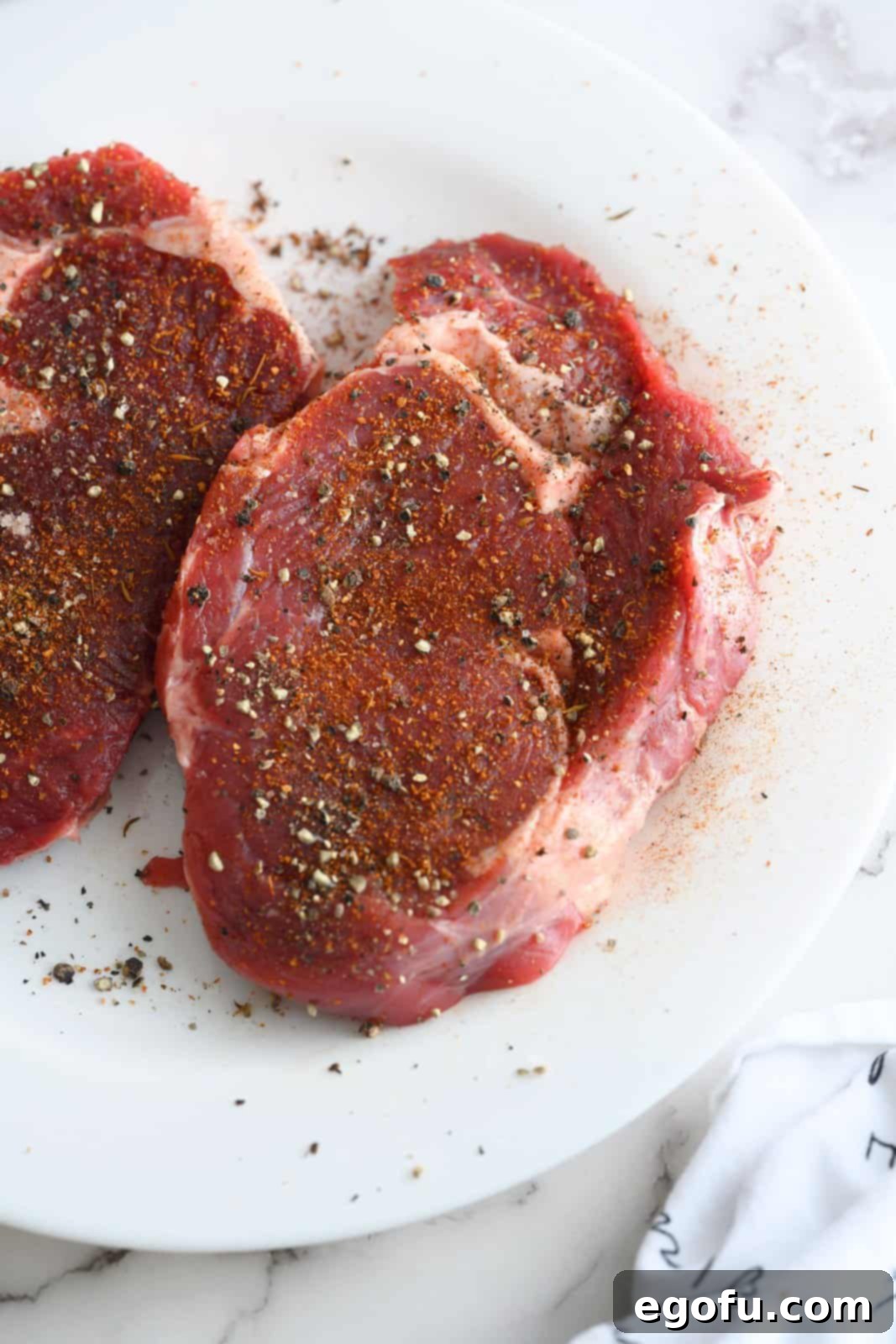
2. Seasoning and Heating the Pan
Generously season both sides of your dry steaks with salt, freshly ground black pepper, and if desired, a good quality Cajun or Creole seasoning for an extra layer of flavor. Don’t be shy with the seasoning; a thick steak can handle a good amount. Next, place your cast-iron skillet over medium-high heat. Add a tablespoon or two of high-heat oil. Let the pan heat up until the oil is shimmering and just begins to smoke lightly – this indicates it’s hot enough for a perfect sear.
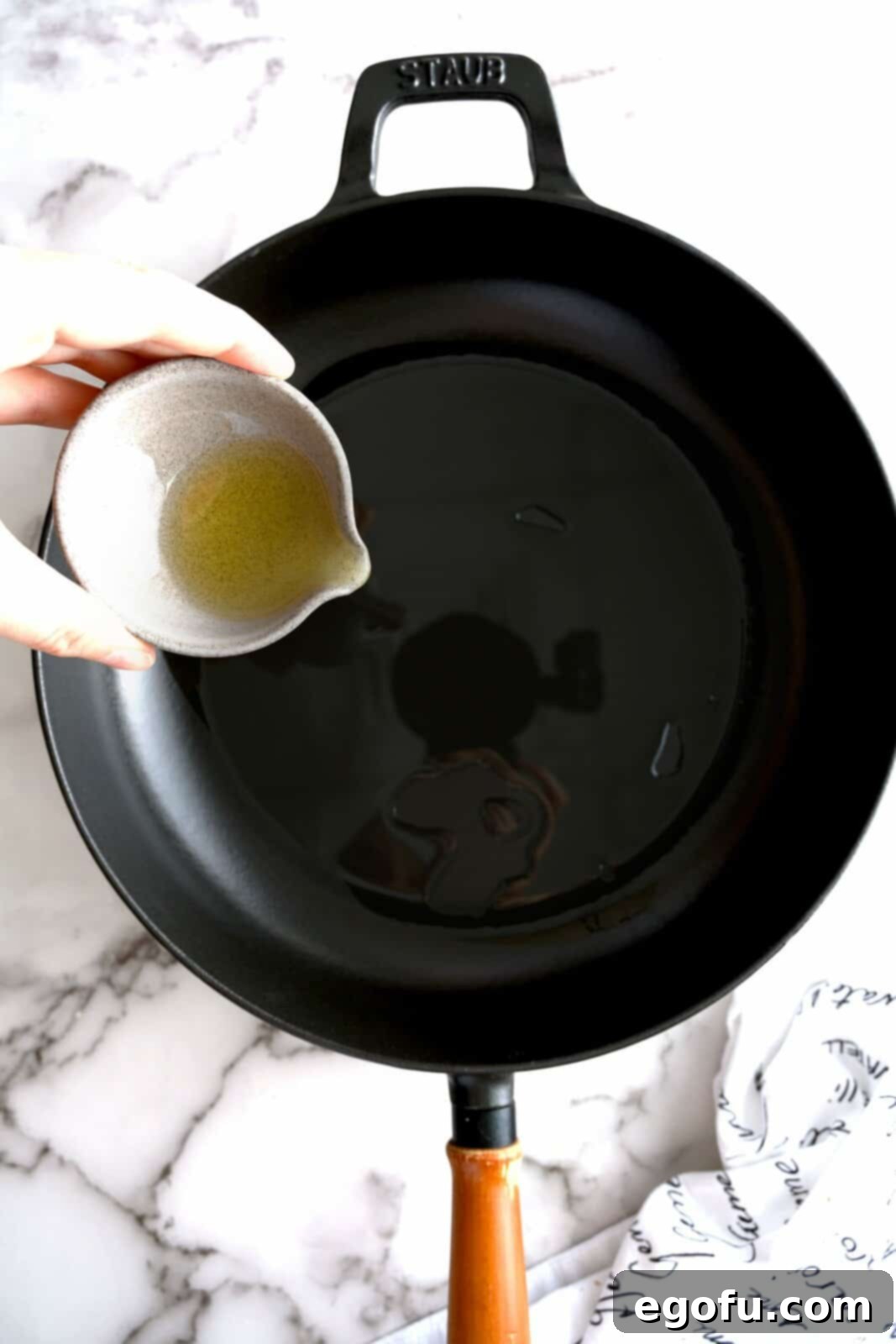
3. Searing for the Golden Crust
Carefully place the seasoned steaks into the hot skillet. Avoid overcrowding the pan; cook one or two steaks at a time, depending on the size of your skillet, to maintain high heat. Sear for about 2-3 minutes per side (for a 1-inch thick steak) or until a beautiful, deep brown crust forms. Use tongs to turn the steaks. For thicker cuts or to ensure a thorough crust, turn the steaks onto their sides to sear the edges for about 1 minute each.
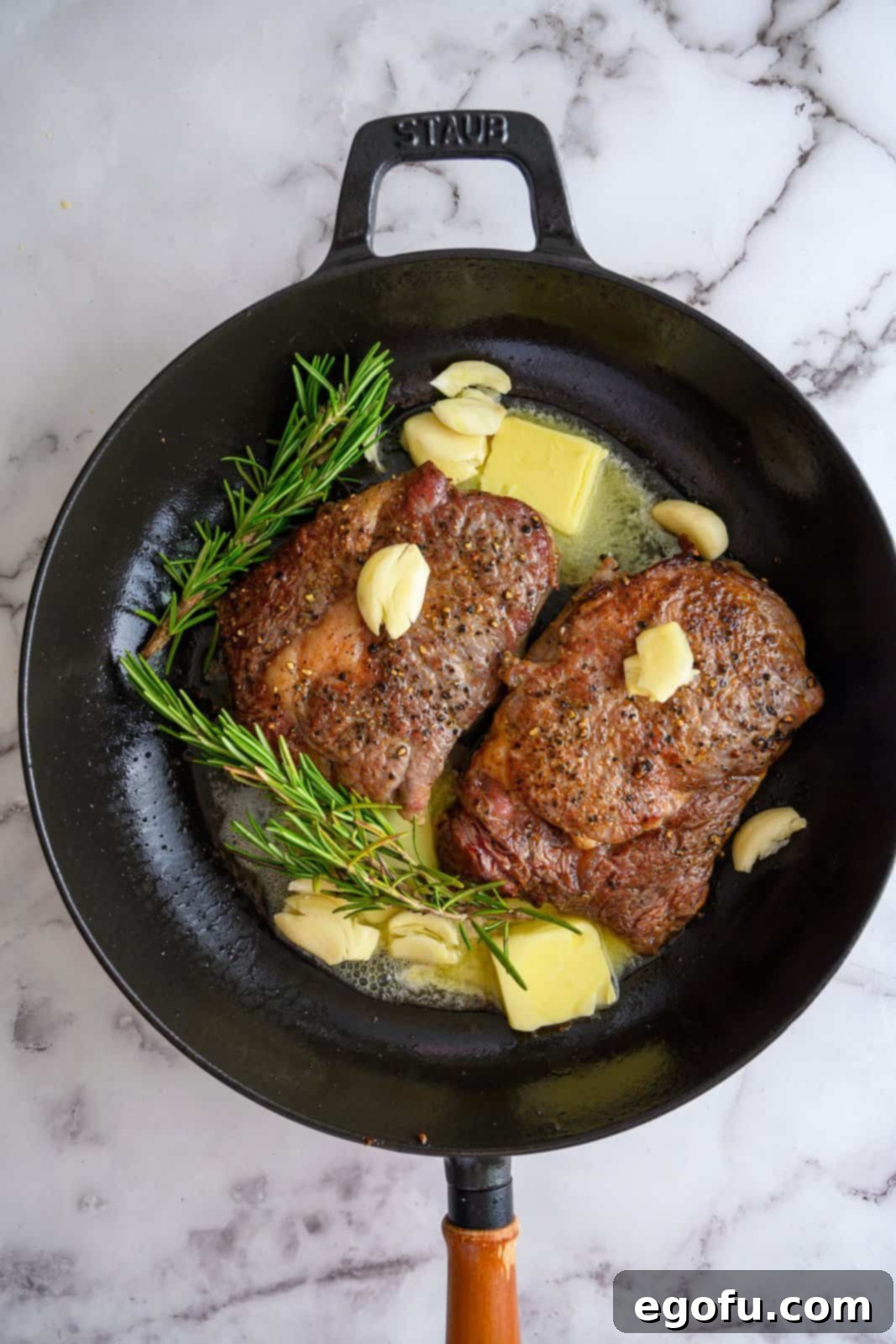
4. Flavor Infusion and Basting
Once both flat sides and edges are seared, reduce the heat to medium-low. Add the butter, smashed garlic cloves, and fresh rosemary sprigs to the pan. Allow the garlic and rosemary to cook for about 1 minute, infusing the butter with their aromatic flavors. Tilt the pan slightly towards you, allowing the melted butter to pool. Using a spoon, continuously baste the steaks with this flavorful butter for another 1-2 minutes, or until the internal temperature of the steaks is about 10 degrees Fahrenheit below your desired final doneness. Basting not only adds incredible flavor but also helps to cook the steak gently and evenly.

5. Achieving Perfect Doneness and Resting
To ensure your steak reaches your preferred level of doneness, use an instant-read thermometer. Insert it into the thickest part of the steak, away from any bone or fat. Remove the steaks from the pan when they are 5-10 degrees Fahrenheit below your target temperature, as they will continue to cook slightly while resting (this is called carryover cooking).
Transfer the cooked steaks to a cutting board, tent them loosely with aluminum foil, and allow them to rest for 5-10 minutes. This resting period is crucial: it allows the muscle fibers to relax and the internal juices to redistribute evenly throughout the meat. Skipping this step can result in a steak that bleeds out its juices when cut, leaving it dry and less flavorful. After resting, slice and serve your perfectly pan-seared steak.
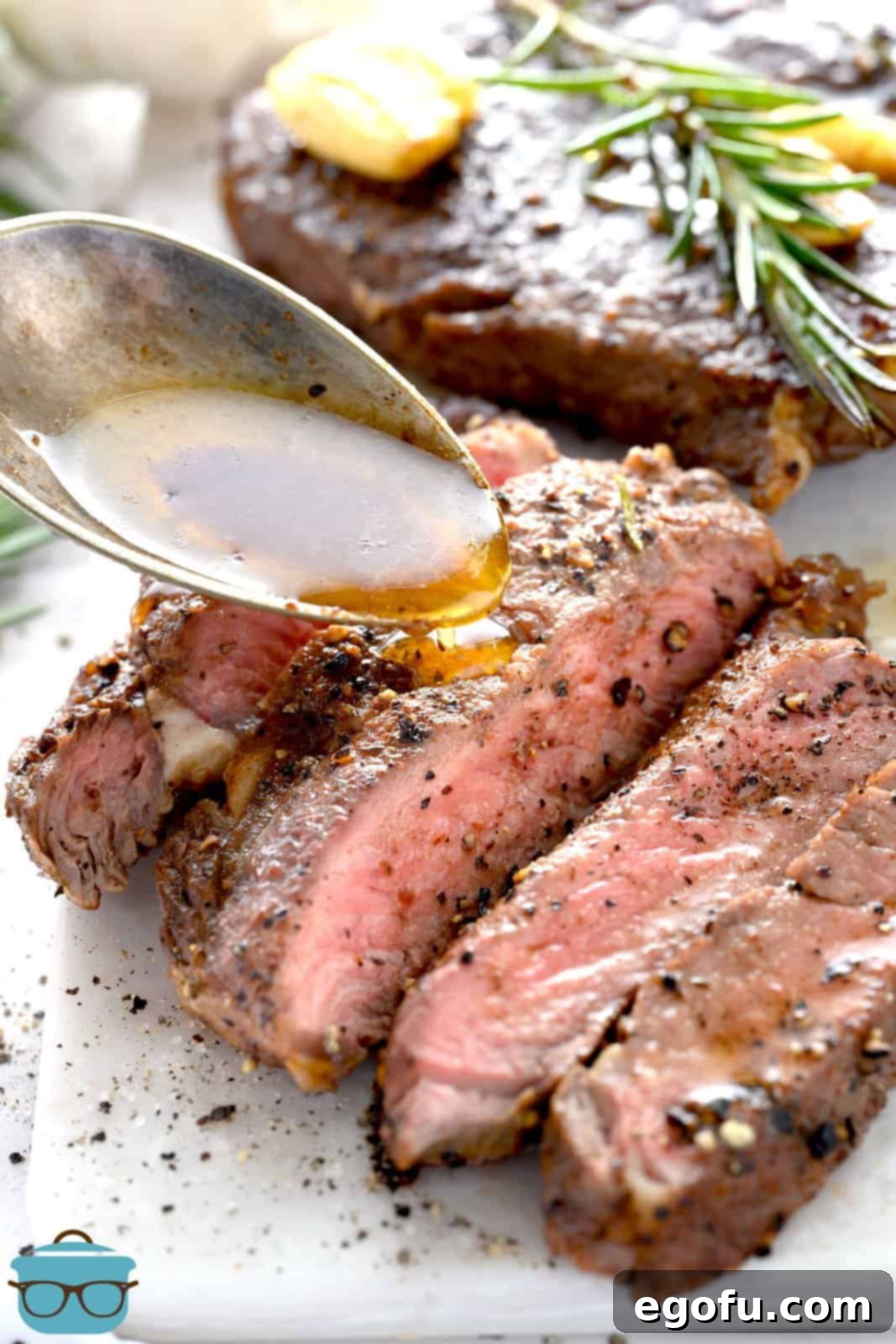
Frequently Asked Questions About Pan-Seared Steak:
For pan-searing, the best cuts are typically those with good marbling (internal fat) and tenderness. Ribeye is widely considered the top choice due to its rich flavor and abundant marbling that melts into the meat, keeping it incredibly juicy. Sirloin is another excellent option, offering a robust beefy taste at a more affordable price point. New York Strip is also fantastic. Aim for steaks that are at least 1 to 1.5 inches thick to allow for a proper crust without overcooking the interior.
A heavy-bottomed cast-iron skillet is the undisputed champion for pan-searing. Its exceptional ability to retain and distribute heat evenly is crucial for achieving that beautiful, consistent brown crust (the Maillard reaction). Cast iron also withstands very high temperatures without warping. A good quality, heavy stainless steel pan can be used as an alternative, but avoid nonstick pans. Nonstick coatings are generally not designed for the high heat required for proper searing and will not develop the same kind of flavorful crust.
The cooking time for pan-seared steak varies based on several factors: the thickness of your steak, its initial temperature, and your desired level of doneness. Generally, for a 1-inch thick steak starting at room temperature, it takes about 3-4 minutes per side to achieve a medium-rare to medium doneness, plus 1 minute per edge for searing. Always use an instant-read thermometer for accuracy rather than relying solely on time.
Using an instant-read thermometer is key to perfect doneness. Here are the recommended internal temperatures (measured when removed from heat, considering carryover cooking):
- Rare: 125-130°F (52-54°C) – Cool red center.
- Medium Rare: 130-135°F (54-57°C) – Warm red center.
- Medium: 135-140°F (57-60°C) – Warm pink center.
- Medium Well: 140-145°F (60-63°C) – Slightly pink center.
- Well Done: 145-150°F (63-66°C) – No pink, slight brown throughout.
Remember, temperatures will rise by 5-10 degrees during resting.
No, Cajun seasoning is entirely optional. It adds a delicious kick and depth of flavor, which many people enjoy with steak. However, at the very least, you should generously season your steak with good quality coarse salt and freshly ground black pepper. These two staples are fundamental for bringing out the natural beefy flavor. You can also experiment with other spices like garlic powder, onion powder, smoked paprika, or dried herbs like thyme or oregano.
Absolutely! Resting is a non-negotiable step for a juicy steak. When meat cooks, its muscle fibers contract, pushing juices towards the center. If you cut into it immediately, those juices will gush out, leaving you with a dry steak. Resting allows the muscle fibers to relax and the juices to redistribute throughout the meat, resulting in a significantly more tender and moist steak. Cover loosely with foil and let rest for at least 5-10 minutes, depending on the steak’s thickness.
Patting your steaks completely dry with paper towels before seasoning and searing is a critical step for achieving a superior crust. Moisture on the surface of the meat will cause it to steam rather than sear when it hits the hot pan. This steaming effect prevents the Maillard reaction from occurring efficiently, resulting in a gray, less flavorful exterior instead of a beautiful, crispy brown crust. A dry surface also helps the seasonings adhere better to the meat.
To store leftover pan-seared steak, allow it to cool completely before placing it in an airtight container. You can also wrap individual pieces tightly in plastic wrap or aluminum foil. Stored properly in the refrigerator, pan-seared steak will maintain its quality for 3-4 days. For best results, slice leftover steak thinly and enjoy cold in salads or sandwiches, or gently reheat in a pan over low heat with a little butter or broth to prevent it from drying out.
Tips for Success and Common Pitfalls
- Don’t Overcrowd the Pan: Cooking too many steaks at once will lower the pan’s temperature, leading to steaming instead of searing. Work in batches if necessary.
- Monitor Heat: Keep an eye on your pan. If it starts smoking excessively, reduce the heat slightly. If the crust isn’t forming, increase it.
- Use a Thermometer: We cannot stress this enough. It’s the most reliable way to ensure perfect doneness every time.
- Don’t Forget to Rest: As detailed above, resting is essential for juicy, tender results.
- Consider a Reverse Sear: For very thick steaks (over 1.5 inches), consider baking them at a low temperature (e.g., 275°F / 135°C) until about 10-15 degrees shy of your target internal temperature, then finishing with a high-heat pan sear for the crust.
Serving Suggestions and Pairings
A perfectly pan-seared steak is a star on its own, but it truly shines when paired with complementary sides and sauces. Consider these delicious options:
- Classic Sides: Creamy mashed potatoes, roasted asparagus, sautéed mushrooms, a fresh green salad with a vinaigrette.
- Elevated Pairings: A vibrant chimichurri sauce, a rich red wine reduction, a simple pan sauce made from the drippings, or caramelized onions.
- Heartier Options: Garlic bread, baked potatoes, or a medley of roasted root vegetables.
The versatility of pan-seared steak allows it to fit perfectly into any meal, whether a casual weeknight dinner or an elegant feast.
Want More Delicious Steak Recipes? You Must Try These!
- Steak Tips with Peppers
- Air Fryer Steak
- Hibachi Steak
- Smoked Pork Steaks
- Grilled Steak & Potato Packets
- Crock Pot Pepper Steak
- Swiss Steak
Pan Seared Steak Recipe Card
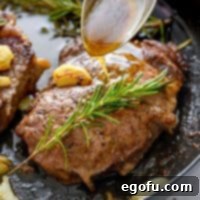
Pan Seared Steak
Pan Seared Steak is much simpler to make than you think! It is an easy and delicious recipe that will have you cooking restaurant quality steaks at home in no time!
Pin Recipe
Prep Time: 5 minutes
Cook Time: 15 minutes
Total Time: 20 minutes
Servings: 2
Author: Brandie Skibinski
Ingredients
- 2 (8 ounce) ribeye steaks, 1-inch thick
- Salt and pepper, to taste
- 1 teaspoon cajun seasoning
- 2 Tablespoons olive oil or any high heat oil
- 3 Tablespoons salted butter
- 7 garlic cloves, smashed with the back of a chef’s knife
- 4-5 rosemary sprigs
Instructions
- Bring steaks to room temperature before cooking. (This allows for a more even cook all the way through).
- Pat them dry with paper towels.
- Heat oil in a large cast-iron skillet over medium high heat.
- Once the oil is hot, season steaks with salt, pepper and cajun creole seasoning on both sides and add to the skillet. Cook for about 2 minutes each side or until you get a nice brown crust. Turn the steaks on their sides to sear the edges (about 1 minute).
- Reduce the heat to medium low. Add the butter, garlic and rosemary sprigs. Cook garlic and rosemary for about 1 minute to release flavors.
- Baste the steaks continuously with the butter for a minute or until they are 10-degrees from your desired doneness. This is easiest if you slightly tilt the pan towards you then use a spoon to scoop up the butter and pour it over the steaks.
- Use an instant-read thermometer to check for doneness. Remove the steaks and cover with aluminum foil and allow them to rest for 5-8 minutes before serving.
Notes
- You can also use sirloin steak for this recipe.
- Make sure the meat is at room temperature before cooking.
- Make sure you use a cast iron skillet.
- Other seasoning can be used.
Course: Main Course
Cuisine: American
Nutrition (Estimated Per Serving)
- Calories: 768 kcal
- Carbohydrates: 4g
- Protein: 47g
- Fat: 63g
- Sodium: 123mg
- Fiber: 1g
- Sugar: 0.2g
Nutritional Disclaimer
“The Country Cook” is not a dietician or nutritionist, and any nutritional information shared is an estimate. If calorie count and other nutritional values are important to you, we recommend running the ingredients through whichever online nutritional calculator you prefer. Calories and other nutritional values can vary quite a bit depending on which brands were used.
Did you make this recipe?
Share it on Instagram @thecountrycook and mention us #thecountrycook!
Armed with this comprehensive guide, you’re now ready to transform ordinary cuts of beef into extraordinary culinary experiences. The perfect pan-seared steak is within your reach, promising a juicy, tender, and deeply flavorful meal that rivals any restaurant offering. Practice makes perfect, so don’t hesitate to experiment with different seasonings and cuts to find your ultimate homemade steak. Enjoy the journey of mastering this classic dish and delight in the delicious results!
